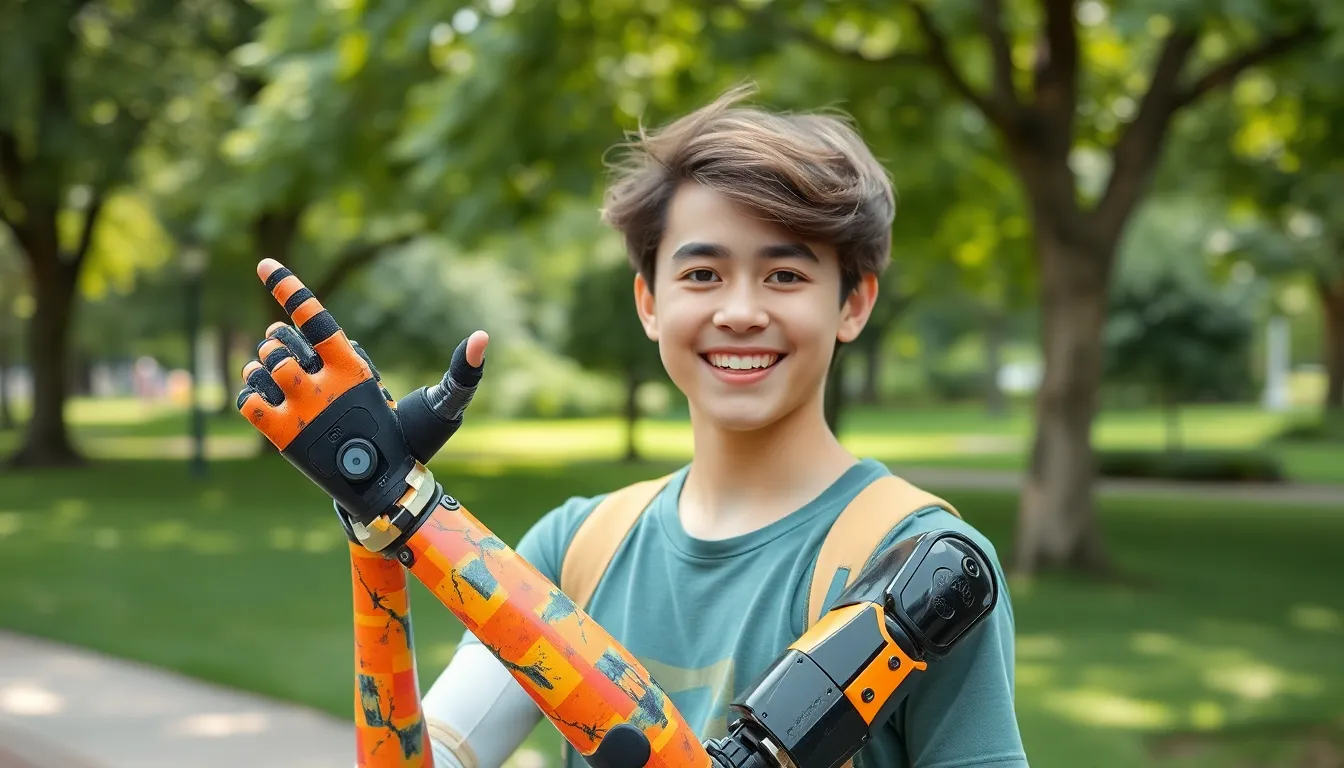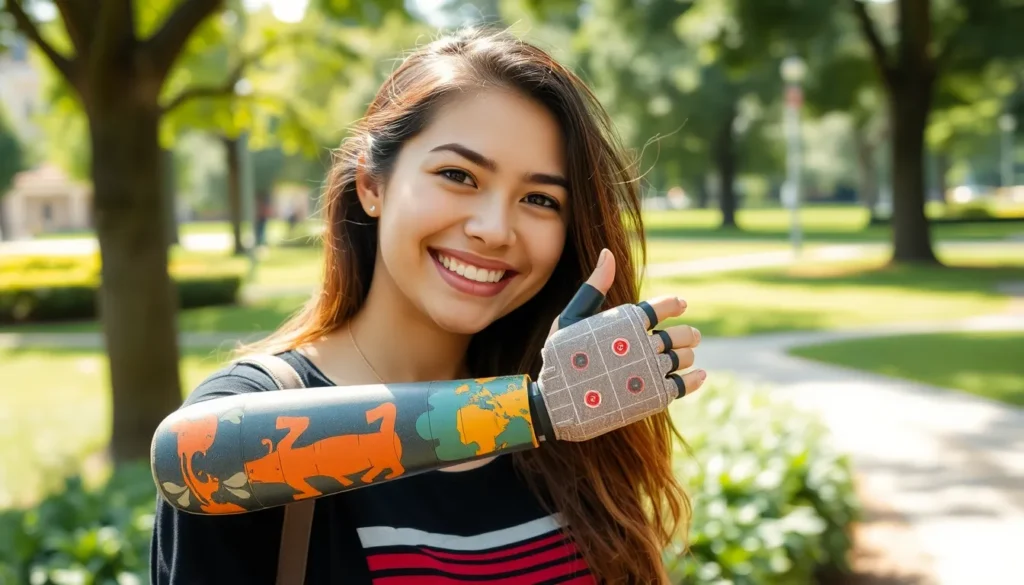Table of Contents
ToggleImagine a world where losing a limb doesn’t mean losing your sense of adventure. Enter 3D printed prosthetics, the game-changer that’s not just functional but also a little bit fabulous. With the power of technology, these custom-made marvels offer a unique blend of style and practicality, making it possible for anyone to strut their stuff with confidence.
Gone are the days of clunky, one-size-fits-all prosthetics. Thanks to 3D printing, individuals can now sport limbs that fit like a glove and reflect their personality. Whether it’s a vibrant color or a quirky design, these prosthetics are more than just tools—they’re a statement. Dive into the fascinating world of 3D printed prosthetics, where innovation meets individuality, and discover how this technology is transforming lives, one limb at a time.
Overview of 3D Printed Prosthetics
3D printed prosthetics revolutionize the field of limb replacement by offering personalized solutions. This technology improves both quality and accessibility of prosthetics.
Definition and Technology
3D printed prosthetics refer to artificial limbs created using additive manufacturing techniques. This process layers materials like plastic and metal to build structures from a digital model. Precision and customization play significant roles, allowing tailored shapes and sizes that meet individual needs. Innovations in scanning and design software enable accurate representations of a person’s anatomy. Customization ensures comfortable fittings, enhancing user experience greatly.
Benefits of 3D Printing in Prosthetics
Numerous benefits accompany the adoption of 3D printing in prosthetics. Lower production costs make these devices more affordable compared to traditional methods. Speed of production often reduces wait times for users, accelerating their return to daily activities. Lightweight materials contribute to enhanced mobility and comfort during use. Unique designs cater to personal preferences, ensuring recipients can express individuality through their prosthetic. Overall, this technology fosters greater independence and quality of life for users.
Types of 3D Printed Prosthetics

3D printed prosthetics come in various types, with each designed to cater to specific needs and functionalities. Users benefit from the customization options that enhance both aesthetics and performance.
Upper Limb Prosthetics
Upper limb prosthetics include devices designed for arms, hands, and wrists. These prosthetics can replicate fine motor skills, often utilizing advanced robotic features for improved functionality. Customization ensures a better fit for the user, enhancing comfort. Many designs incorporate vibrant colors and patterns, allowing individuals to express their personality. Materials chosen for these prosthetics are lightweight yet durable, promoting better mobility during daily activities. Additionally, some upper limb prosthetics include sensory feedback systems, enabling users to interact more naturally with their environment.
Lower Limb Prosthetics
Lower limb prosthetics include designs for legs, feet, and ankles, targeting mobility and stability. These devices often incorporate flexible components that mimic natural movement, facilitating walking and running. Specific designs can accommodate various activity levels, from casual walking to high-performance sports. Custom fittings contribute to improved comfort and alignment, reducing the risk of injury. Advanced cushioning materials in these prosthetics enhance shock absorption during impact. Additionally, appealing styles and colors allow for personalization, reinforcing the confidence of users as they engage with their surroundings.
Customization and Personalization
3D printed prosthetics excel in customization, offering tailored solutions for individual needs. These advancements allow for the creation of patient-specific designs that enhance comfort and functionality.
Patient-Specific Designs
Patient-specific designs leverage advanced scanning technology to create precise models of the individual’s residual limb. Each prosthetic is crafted to fit the unique contours, ensuring optimal comfort and functionality. This personalization leads to improved mobility, reducing the likelihood of discomfort during daily activities. Adjustments can be made quickly, accommodating any changes in shape or size over time. Costs decrease due to streamlined production processes. The sense of ownership that users gain from their one-of-a-kind prosthetics fosters confidence and independence.
Aesthetics and Functionality
Aesthetics play a vital role in the appeal of 3D printed prosthetics. Users can choose colors, patterns, and accessories that reflect their style, enhancing personal expression. Functionality remains a priority, ensuring that these customized designs do not compromise performance. Many prosthetics now feature advanced engineering that mimics natural movement while maintaining a lightweight profile. Emphasizing both look and utility, manufacturers focus on vibrant designs that users enjoy wearing. Overall, striking the right balance between aesthetics and functionality boosts user satisfaction, leading to better quality of life.
Case Studies and Success Stories
3D printed prosthetics showcase remarkable advancements in limb replacement technology. Exceptional real-world applications demonstrate their impressive impact on users’ lives.
Innovative Applications
Various organizations implement 3D printing technology to create tailored prosthetics. One notable application involves hospitals collaborating with local universities to develop custom limbs for children. These collaborations improve accessibility and affordability of prosthetics. Personalized designs not only meet specific medical needs but also reflect each child’s favorite colors or characters. Additionally, companies engage in rapid prototyping, resulting in quicker turnarounds for unique designs. Users benefit from lightweight materials, which enhance comfort during daily activities. Overall, innovative applications of 3D printing continue to transform prosthetics, making them more effective and appealing.
Patient Testimonials
Numerous individuals share inspiring stories about their experiences with 3D printed prosthetics. A teenage athlete expresses joy at receiving a prosthetic arm designed with bright colors that match her sports uniform. Another user notes that his custom leg prosthetic improved mobility, allowing him to pursue hiking again. Parents often highlight the emotional relief that accompanies seeing their children embrace life with confidence. Testimonials frequently emphasize how these advancements foster a sense of individuality, making users feel more like themselves. Overall, feedback rounds out the picture, illustrating the profound effects of 3D printed prosthetics on everyday life.
Future of 3D Printed Prosthetics
The future of 3D printed prosthetics promises significant advancements and improved patient experiences. Technological developments streamline production processes and enhance design capabilities.
Advancements in Technology
Innovative materials increase prosthetic durability and comfort. New software enhances design precision, allowing for intricate personalization. Improved scanning techniques create detailed models from residual limbs, ensuring optimal fit. Recent developments in robotics improve functionality, enabling better movement and control. Collaboration among engineers, healthcare professionals, and patients drives a future filled with creativity and innovation.
Potential Challenges
Despite advancements, challenges remain in the realm of 3D printed prosthetics. Regulatory hurdles may slow the approval process for new products. Limited access to specialized printers in some regions affects availability. Cost variations can lead to disparities in access for individuals. Ensuring long-term durability and functionality of these custom devices presents ongoing concerns. Addressing these challenges directly impacts the success and widespread adoption of this transformative technology.
The evolution of 3D printed prosthetics marks a significant leap in the field of limb replacement. By marrying technology with personal expression these innovative solutions empower users to embrace their individuality while enhancing functionality. The advancements in customization not only improve comfort and fit but also foster a sense of ownership that traditional prosthetics often lack.
As the technology continues to evolve the potential for greater accessibility and affordability becomes more promising. With ongoing developments in materials and design processes the future holds exciting possibilities for those in need of prosthetic limbs. Ultimately 3D printed prosthetics are reshaping lives and redefining what it means to live with confidence and style.

